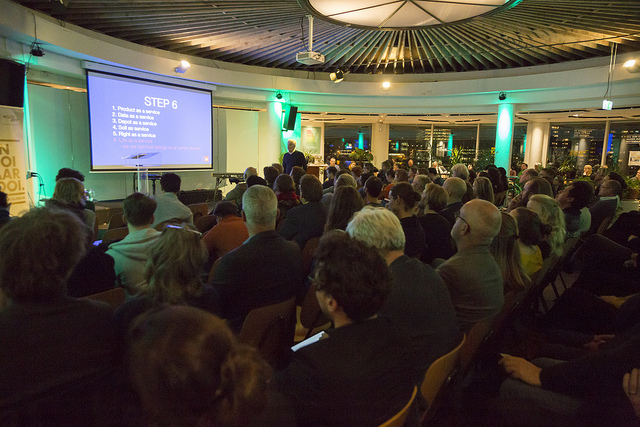
On the 10th of January 2019 I visited Club Circulair at Blue City Rotterdam. Blue City is a former tropical swimming pool. It closed over 10 years ago, because it didn’t make enough money to keep it running or guarantee the safety of its visitors. Now it facilitates research centers for making food out of waste, a circular restaurant and several spaces to organize conferences (mostly on topics about circular economy).
I came here to build a network: to meet like-minded people and bundle our ideas, talents and efforts and share our knowledge. Circularity has nothing to do with keeping ones knowledge to oneself, but being open-source, sharing research and places where to find materials for our small businesses.
When I arrived I soon found our that the majority of the people present worked for the Department Sustainability of the city Rotterdam. This was a public event, but also the New Year conference of that department where the goals were presented by spirited speakers, like Thomas Rau (RAU), Elaizabeth Boersma and Bernadette Janssen.
Since this was about Rotterdam and the speakers were mainly architects, I disposed of the idea of meeting many small business-owners like myself (I did meet some). But what I learned was well worth being there. If only to hear Thomas Rau speak (if you have the chance to go to a conference where he is a speaker, don’t hesitate and go! It is well worth your time and you will feel much happier after, I promise.).
The first person to speak was Harm-Jan Polter, alderman sustainability of Rotterdam. He mentioned the city-plans of Rotterdam, where the city will be 100% circular by 2050, but that in 2030 circular economy will be the norm. Rotterdam also has its own climate agreement for 2019, containing circularity of materials and the reduction of waste. Waste-parks (milieuparken), where citizens of Rotterdam “park” their larger waste (furniture, rubble, …) will be re-organized into a place where businesses can find new materials for their products. Also more of these products need to end up at charity-shops or thrift stores. Rotterdam also invests in finding more sustainable ways to produce (clean) energy. But the main focus for 2019 (and this conference) is the building-sector. When old, unsafe, or discarded buildings are brought down, they are not being dismantled. A lot of materials could be re-used, but everything ends up on one huge pile of rubble. All building and wrecking companies are called upon to dismantle old buildings and houses, so the materials can be re-used in the new ones, to be build at the same spot. Also the building companies need to call upon local labor, (re-)educating unemployed people at the job, so they have a renewed sense of purpose, working experience and maybe even discover new talents.
Bernadette Janssen (BVR adviseurs) advises the city how to re-organize old shipyards into facilities the city will need to become a circular economy. It is not sustainable to transport materials back and forth, while spaces around the former harbor are not being used to their capacity. She also advises to build public information-centers, where the public can visit and learn about circular economy, that waste is the only sustainable source for materials and where they can buy circular (local) produced products.
Elizabeth Boersma (architect at Plan B) talks about Urban Mining: inventorying and the deconstruction of old public and private buildings and re-using these materials in the new projects, saving money and raw materials, while using locals builders and local unemployed people as their trainee-labor.
Thomas Rau (RAU architects) seconds this. Everything (all items existing) need a passport, containing the materials they are made with. Since the Earth is limited, everything we mine from the Earth, every resource, every raw material, every single item is a limited edition. Eventually we will run out of that material, if we keep burning our waste. Inventorying is the only way to go forwarth. “Sustainabiliy is optimizing the system. Circularity is creating a new system.” (Thomas Rau).
By inventorying literally everything we have, we can create this new system. Because then we know where the materials are that we borrowed from the Earth, and we can re-use them when no longer needed in their previous form. The only things that aren’t limited are the sun, our imagination and the amount of data that we are able to save. We have to make use of those unlimited sources, to maintain the limited editions.
Thank you Harm-Jan, Bernadette, Elizabeth and Thomas, for this wonderful and so important evening. I will remember it for a long time and I hope to see and hear you more often.